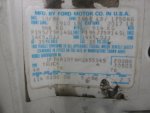wildbill23c
10+ Year Member
TRS 20th Anniversary
U.S. Military - Veteran
TRS Banner 2012-2015
Ham Radio Operator
- Joined
- Aug 22, 2012
- Messages
- 3,918
- Points
- 1,601
- City
- Southwestern Idaho
- Vehicle Year
- 1987
- Engine
- 2.9 V6
- Transmission
- Manual
- Total Lift
- 0
- Total Drop
- 0
- Tire Size
- 215/70-R14
- My credo
- 19K, 19D, 92Y, 88M, 91F....OIF-III (2004-2005)
I can't give you exact weight for your truck, but from my '83 brochures, the curb weights for a RCLB 2.0/manual/6.75" are 1,534 lbs front/1,025 lbs rear = 2,559 lbs total. So, your rated rear capacity is just under 1,000 lbs. And the 1st thing you need to remove from that is your weight - in my case, it would be ~90 lbs, leaving me with only ~900 lbs on rear.
You haven't given us front GAWR or GVWR, so I'll switch to my daughter's 4th gen RCSBs: the curb weights are 1,872 lbs front/1,292 lbs rear =3,164 lbs total GAWR are 2,350 lbs front/2,250 lbs rear, GVWR of 4,420 lbs. So, her truck has rated capacity of ~478 lbs front, ~958 lbs rear, 1,256 lbs total (very close to the brochure 1,260 lbs payload) - after I climb in, the numbers drop to ~350 lbs front/870 lbs rear/1,035 lbs total.
So, when I load the box with dirt I make sure to fill the front of the box right up to the rails, while leaving unfilled near tailgate - I need to get as at least 150 lbs on front axle or I hit rear GAWR before I've loaded the whole 1,000 lbs.
But wait a moment - my other daughter has basically the exact some truck- trucks are even both red, they are that similar. But her truck has GAWR are 2,300 lbs front/2,750 lbs rear, GVWR of 4,740 lbs. The difference - Thing 2's truck has HDPP - so, has 3 leaf springs instead of 2 leaf ones and 225/70R15s instead of 235/60R15s tires.
Back to your truck - the actual axle is probably rated for 2,750 lbs (assuming you don't have a 6.75", in which case your axle is rated 2,200 lbs). But based on the magic combination of springs, tires and expected curb weight, Ford rated it lower. And unfortunately, there is not legal way to say, "I have installed 3 leaf springs and 225/70R15 tires on Thing 1's truck, so it should have rear GAWR of 2,750lbs." If fact, I will have lost rated payload capacity as 3 leaf springs are heavier as are the tires. But whether hauling or towing, you are significantly below the limits of the truck.
I find towing a trailer to be more convenient in a lot of cases: It's a PIA to load the jet ski in/out of the truck bed, same for the snowmobile. Filling HF style 4x8 trailer with dirt, means I can park it beside the house and slowly unload it into wheelbarrow, rather than dump it on driveway and load from ground into the wheelbarrow. I also, find the Ranger's brakes sketchy at best of time - daughter's Rangers have 10-1/4" fronts/9" rear. If load is over 750 lbs, a trailer with well set up brakes actually stops faster than hauling the load.
I assume the door sticker would be of help.













